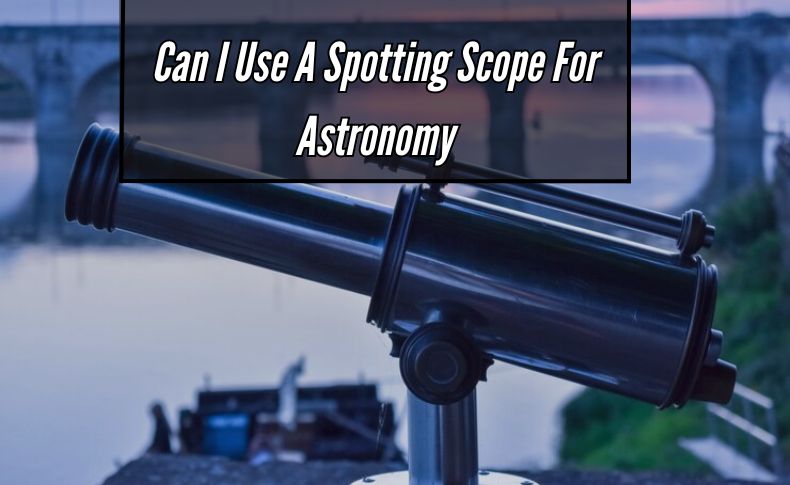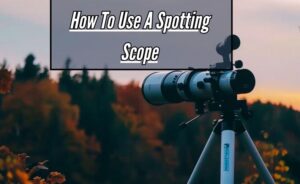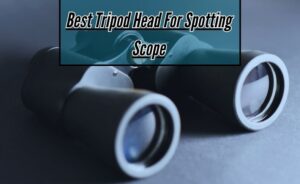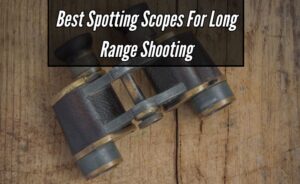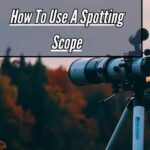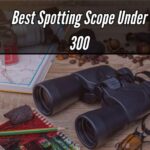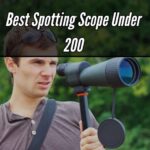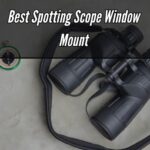Consider using a spotting scope to observe stars. You’re not by yourself! Many people ask if these useful gadgets can also be used as astronomical equipment. The short answer is that you absolutely can. Spotting scopes can provide a view of the night sky in addition to being useful for birdwatching and landscape viewing.
Yes, astronomy can be done using a spotting scope! Spotting scopes are a terrific tool for beginning or casual stargazers to use to explore the night sky. Spotting scopes can nonetheless offer sharp views of the moon, planets, and even some brighter deep-sky objects, even if they do not have all the capabilities of a dedicated astronomy telescope.
You can view astronomical objects like the Moon, planets, and even certain deep-sky wonders like star clusters and nebulae with their powerful magnification and excellent optics. Spotting scopes can nevertheless make for exciting stargazing excursions, even though they might not equal the precision of a specialized telescope—especially for novices or casual observers. Therefore, if you already have a spotting telescope with you, don’t be afraid to aim it upward and observe the universe from a new perspective.
Navigating the Cosmos: Assessing Ease of Use in Astronomy Spotting Scopes
Navigating the cosmos with astronomy spotting scopes opens up a world of wonder, but ensuring ease of use is essential for a fulfilling experience. Here are some key aspects to consider when assessing the user-friendliness of these scopes:
Optical Quality and Clarity:
The quality of optics plays a significant role in determining how clearly you can observe celestial objects. Look for spotting scopes with high-quality lenses and coatings that minimize distortion and enhance image clarity. A crisp and clear view of the cosmos makes for a more enjoyable stargazing experience.
Portability and Convenience:
Whether you’re observing from your backyard or a remote stargazing site, portability is crucial. Opt for a spotting telescope that is lightweight and easy to transport, allowing you to set up and start observing quickly.
Compact designs and carrying cases add to the convenience, making it easier to take your scope wherever your astronomical adventures lead.
Ease of Setup and Alignment:
Setting up a spotting scope should be straightforward, even for beginners. Look for scopes with intuitive alignment procedures and user-friendly setup instructions.
Features like quick-release mounting brackets and easy-to-adjust tripods simplify the setup process, so you can spend less time fiddling with your equipment and more time stargazing.
User Interface and Controls:
A user-friendly interface and intuitive controls are essential for seamless operation. Smooth focusing mechanisms, ergonomic adjustment knobs, and well-designed zoom controls make it easy to fine-tune your view of the cosmos.
Look for spotting scopes with ergonomic designs that are comfortable to use for extended periods, especially during long stargazing sessions.
Accessories and Compatibility:
Enhance the versatility of your spotting scope with compatible accessories. Smartphone adapters, camera mounts, and eyepiece filters are just a few accessories that can enhance your observing experience and open up new possibilities for astrophotography.
Choose a spotting scope that offers compatibility with a wide range of accessories to customize your setup to suit your needs.
Stargazing in Style: Evaluating Durability of Spotting Scopes for Astronomy

Exploring the cosmos through a spotting scope can be an enthralling experience, but ensuring the durability of your equipment is crucial for a seamless stargazing adventure.
Here, we delve into the key factors to consider when evaluating the durability of spotting scopes for astronomy.
Construction Quality:
The durability of a spotting scope heavily relies on its construction quality. Opt for scopes crafted from sturdy materials like aluminum or magnesium alloy, as they offer resilience against wear and tear, ensuring longevity.
Weather Resistance:
Astronomy enthusiasts often venture outdoors, exposing their equipment to various weather conditions. Look for spotting scopes with weather-resistant features such as nitrogen purging and O-ring seals to safeguard against moisture, dust, and debris ingress.
Optical Components:
The optical components of a spotting scope play a vital role in its durability and performance. High-quality lenses with multiple coatings enhance durability by providing scratch resistance and protection against abrasions, ensuring clear views over prolonged usage.
Mechanical Stability:
Stability is paramount for prolonged stargazing sessions. Opt for spotting scopes equipped with robust mounting systems and adjustable tripods to minimize vibrations and ensure steady observation, enhancing both durability and viewing experience.
Shock Absorption:
When transporting your spotting scope to different stargazing locations, it’s essential to consider its shock absorption capabilities.
Look for scopes with shock-resistant features such as rubber-armored coatings or internal shock-absorbing mechanisms to mitigate impacts during transit, preserving their structural integrity.
Field Testing:
Before making a purchase, consider field-testing the spotting scope under real-world conditions. Assess its performance in varying temperatures, humidity levels, and terrain to gauge its durability and suitability for your stargazing needs.
Maintenance and Care:
Proper maintenance and care are imperative for prolonging the lifespan of your spotting scope. Regularly clean the lenses, avoid exposing the equipment to harsh elements when not in use, and store it in a protective case to prevent damage and ensure lasting durability.
Crafting Cosmic Visions: Configuring Spotting Scopes for Astronomical Exploration
Exploring the Cosmos: An Introduction
Embarking on a journey through the vastness of space is a thrilling endeavor that captivates the imagination of many. Whether you’re a seasoned astronomer or a newcomer to stargazing, configuring your spotting scope for astronomical exploration is key to unlocking the wonders of the universe.
Understanding Spotting Scopes: Basics and Beyond
Spotting scopes serve as powerful tools for observing celestial objects, offering magnification and clarity to distant phenomena. Understanding the basics of spotting telescopes, including aperture, magnification, and field of view, lays the foundation for configuring your equipment for optimal stargazing experiences.
Optimizing Magnification: Finding the Sweet Spot
One of the critical factors in configuring your spotting scope for astronomical exploration is optimizing magnification. While higher amplification may seem desirable, it can lead to image distortion and reduced brightness.
Finding the sweet spot that balances magnification with image quality is essential for observing celestial objects with clarity and detail.
Calibrating for Low-Light Conditions: Enhancing Visibility
Astronomical exploration often occurs in low-light conditions, necessitating adjustments to your spotting scope’s settings for enhanced visibility.
Calibrating your equipment to maximize light-gathering capabilities, such as adjusting the exit pupil and selecting appropriate eyepieces, ensures optimal performance when observing faint celestial objects.
Navigating the Night Sky: Utilizing Star Charts and Apps
Navigating the night sky is an integral part of astronomical exploration, allowing observers to locate specific celestial objects with precision.
Utilizing star charts, astronomy apps, and celestial coordinates aids in identifying stars, planets, nebulae, and other fascinating phenomena, enhancing the overall stargazing experience.
Capturing Cosmic Moments: Astrophotography with Spotting Scopes
For those seeking to capture the beauty of the cosmos through photography, configuring spotting scopes for astrophotography opens up a world of possibilities.
With the right adapters, cameras, and techniques, spotting telescopes can serve as versatile tools for capturing stunning images of distant galaxies, star clusters, and planetary surfaces.
Spotting Scope Selection: Unlocking Optimal Magnification for Astronomical Observations
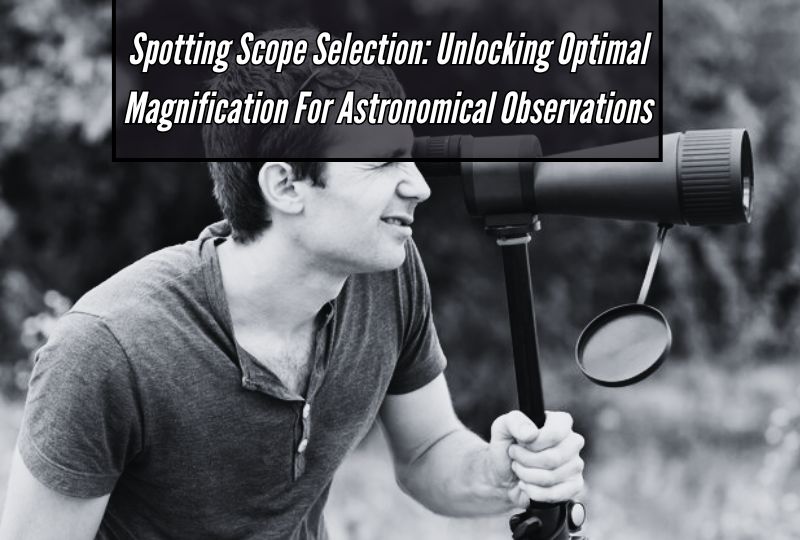
When it comes to selecting the right spotting scope for astronomical observations, understanding the concept of magnification is crucial. Here’s a breakdown to help you navigate this essential aspect:
Understanding Magnification:
Magnification refers to how much closer an object appears when viewed through the spotting scope compared to the naked eye.
In astronomical observations, higher magnification allows you to see celestial objects in greater detail, but it’s essential to strike a balance to avoid image distortion and loss of brightness.
Consider Aperture Size:
The aperture size of the spotting scope plays a significant role in determining the optimal magnification. A larger aperture allows more light to enter the scope, resulting in brighter and clearer images, especially when observing faint celestial objects such as galaxies and nebulae.
Factor in Focal Length:
The focal length of the spotting scope influences its magnification capabilities. Longer focal lengths generally result in higher magnification, while shorter focal lengths provide a wider field of view.
For astronomical observations, a balance between amplification and field of view is essential to capture both detailed views of celestial objects and broader vistas of the night sky.
Choose the Right Eyepiece:
Selecting the appropriate eyepiece is key to achieving optimal magnification. Different eyepieces offer varying amplification levels, so it’s essential to choose one that complements your spotting scope and observing needs.
Additionally, investing in quality eyepieces can significantly enhance your viewing experience by minimizing aberrations and maximizing clarity.
Consider Atmospheric Conditions:
Atmospheric conditions, such as air turbulence and light pollution, can affect the perceived magnification and image quality when observing celestial objects. Optimal viewing conditions, such as clear, dark skies with minimal atmospheric disturbance, can enhance the effectiveness of higher magnification settings.
Experiment and Adjust:
Finding the optimal magnification for astronomical observations often involves experimentation and adjustment. Start with lower amplification settings to locate celestial objects, then gradually increase the magnification to observe finer details.
Pay attention to image clarity, brightness, and overall viewing comfort, and don’t hesitate to make adjustments as needed to optimize your observing experience.
Delving into the Deep: Close Focus Capabilities of Spotting Scopes for Astronomy
Spotting scopes, often associated with terrestrial observation, hold a hidden gem for astronomers: their remarkable close focus capabilities.
While primarily designed for birdwatching, nature observation, and surveillance, spotting scopes can be invaluable tools for astronomers seeking detailed views of celestial objects.
Understanding Spotting Scopes:
Spotting scopes are optical instruments equipped with high-quality lenses and prisms, designed to deliver high magnification and clarity over long distances. They typically feature large objective lenses, which gather ample light for clear viewing even in low-light conditions.
Close Focus Capabilities:
One of the lesser-known features of spotting scopes is their ability to focus on nearby objects with remarkable detail. While astronomical telescopes excel at observing distant stars and galaxies, spotting scopes offer a unique advantage by allowing astronomers to explore objects within our solar system, such as the Moon, planets, and even distant comets, with exceptional clarity.
Ideal for Lunar and Planetary Observation:
The close focus capabilities of spotting scopes make them ideal for observing the intricate details of the lunar surface. Lunar craters, mountains, and valleys come to life when viewed through a high-quality spotting telescope, offering amateur astronomers a breathtaking experience akin to that of professional observatories.
Similarly, spotting scopes provide excellent views of the planets in our solar system. Features such as Jupiter’s cloud bands, Saturn’s rings, and the changing phases of Venus can be observed with surprising clarity, making spotting scopes a versatile tool for planetary observation.
Enhancing Astrophotography:
Spotting scopes can also serve as valuable instruments for astrophotography enthusiasts. When paired with a sturdy tripod and a compatible camera adapter, spotting telescopes allow photographers to capture stunning images of celestial objects with ease.
Their close focus capabilities enable detailed shots of the Moon, planets, and even deep-sky objects like star clusters and nebulae.
Portable and Versatile:
Unlike traditional astronomical telescopes, spotting scopes are compact and lightweight, making them highly portable. This portability allows astronomers to set up their observation stations quickly and easily, whether in their backyard, a remote dark-sky site, or even while on the go.
Setting Your Sights Skyward: Exploring Eyepiece Angles in Astronomy Spotting Scopes
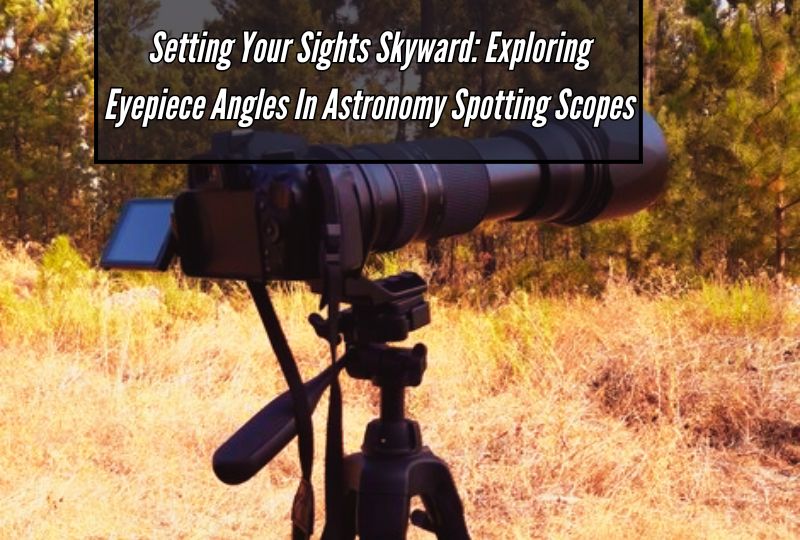
In the realm of astronomy, the way we view celestial objects can greatly influence our understanding and appreciation of the cosmos. One key component in this endeavor is the angle of the eyepiece in spotting scopes, which can significantly impact the clarity and comfort of observation. Let’s delve into this fascinating aspect of stargazing.
Understanding Eyepiece Angles
The angle of the eyepiece, often referred to as the “field of view“, determines the width of the sky visible through the telescope at any given moment.
A wider angle provides a broader view of the heavens, allowing observers to take in more celestial wonders at once. Conversely, a narrower angle offers a more focused and detailed view of individual objects.
Optimizing Comfort and Viewing Experience
Finding the right eyepiece angle is crucial for a comfortable and enjoyable observing session. An angle that is too steep can strain the neck and back, leading to discomfort and fatigue over time.
On the other hand, an angle that is too shallow may require awkward positioning or contortion, detracting from the overall experience. It’s essential to strike a balance that allows for relaxed and ergonomic viewing.
Adapting to Different Scenarios
Different observing scenarios may call for varying eyepiece angles. For wide-field viewing of expansive star clusters or nebulae, a wider angle can enhance the sense of immersion and scale.
Conversely, for precise observations of planets or double stars, a narrower angle may be preferable to isolate and scrutinize individual details with greater clarity.
Considering Telescope Design and Mounting
The design of the telescope and its mounting system can also influence the optimal eyepiece angle. Refracting telescopes, with their long tubes and diagonal eyepiece orientation, may require different angles compared to reflecting telescopes with their open tubes and straight-through viewing.
Similarly, the type of mounting, whether equatorial or alt-azimuth, can affect the comfort and ease of adjusting the eyepiece angle during observation sessions.
Experimenting and Fine-Tuning
Finding the perfect eyepiece angle often involves a process of experimentation and fine-tuning. Astronomers are encouraged to explore different angles and observe how they impact their viewing experience.
Adjustments can be made based on personal comfort, observing preferences, and the specific characteristics of the celestial objects being viewed. Over time, this experimentation can lead to a deeper understanding of how eyepiece angles influence astronomical observation.
Stars on a Budget: Tailoring Astronomy Spotting Scopes to Your Financial Plan
Exploring the vastness of the night sky and witnessing the beauty of stars need not be an expensive endeavor. With careful consideration and planning, it’s possible to enjoy astronomy on a budget by tailoring your equipment choices to fit your financial plan.
Understanding Your Needs:
Before delving into purchasing decisions, assess your requirements. Are you a beginner or an experienced observer? Do you plan to focus on specific celestial objects or have a broader interest? Understanding your needs will guide you in selecting the most suitable equipment within your budget.
Researching Affordable Options:
In today’s market, there’s a wide range of astronomy spotting scopes available at varying price points. Conduct thorough research to identify reputable brands offering quality scopes at affordable prices. Look for reviews and user feedback to gauge the performance and reliability of different models.
Balancing Features and Cost:
While it’s tempting to opt for the most feature-rich telescope, consider the trade-off between features and cost. Determine which features are essential for your observing goals and prioritize those within your budget. Remember that a more expensive telescope doesn’t always guarantee better performance.
Exploring Second-hand Markets:
Don’t overlook the option of purchasing used equipment. Websites, forums, and local astronomy clubs often have classified sections where individuals sell pre-owned telescopes and accessories at discounted prices. Just ensure the equipment is in good condition before making a purchase.
Investing in Essential Accessories:
To enhance your observing experience without breaking the bank, invest in essential accessories such as eyepieces, filters, and tripod mounts. These accessories can improve the functionality and versatility of your telescope without significant additional costs.
Maximizing Value for Money:
Seek out bundle deals or packages that offer a combination of telescope and accessories at a discounted price. Additionally, keep an eye out for sales, promotions, and clearance events where you may find quality telescopes at reduced prices, allowing you to maximize the value for your money.
Conclusion:
In conclusion, casual stargazers may find that a spotting scope is not the ideal option, even though it might be useful for simple stargazing. You may not be able to see details on planets and faint celestial objects due to its restricted aperture and magnification capabilities. A spotting telescope can still be fun, though, especially for casual observation or astronomy beginners.
Don’t forget to take your own requirements and tastes into account while selecting the gear for your stargazing excursions. Purchasing a telescope made especially for astronomy could prove to be a more fruitful investment if your ultimate goal is to explore the cosmos to a greater depth.
Frequently Asked Questions (FAQs)
What magnification is suitable for astronomy with a spotting scope?
Choose a spotting scope for astronomy that strikes a balance between brightness and detail when choosing a amplification. A magnification that is too high may dull the image and make it more difficult to discern faint objects. A spotting telescope with a 20x to 60x magnification range is appropriate for astronomy. The moon, planets, and other brighter deep-sky objects can all be observed with sufficient amplification within this range, all the while preserving a bright and clear image.
Although it could be tempting, higher magnifications might worsen air distortion and lower the clarity of the image. For the greatest astronomical experience with a spotting telescope, take into account not just magnification but also aperture size and optical quality.
Do I need a specific mount for astronomical use?
Having a dedicated mount for astronomy purposes can improve vision significantly. While a spotting scope can be used without a mount, watching celestial objects requires the stability and accuracy tracking that an astronomy mount offers. There are several kinds of mounts available, such as equatorial and alt-azimuth mounts. Simpler and more suited for casual observation, alt-azimuth mounts move in both horizontal (azimuth) and vertical (altitude) directions.
Equatorial mounts are more intricate, but they make it possible to follow celestial objects precisely as they travel across the sky. Think about things like weight capacity, compatibility with your spotting scope, and convenience of use when selecting a mount. Purchasing a good mount guarantees more fun and seamless stargazing experiences.
Can spotting scopes be used for astrophotography?
It is true that spotting scopes can be used for astrophotography, albeit they might not be the best option when considering specialized astronomical telescopes. Generally speaking, spotting scopes are smaller and have a narrower field of vision than telescopes made especially for astrophotography. They can still take stunning pictures of the moon, planets, and other deep-sky objects, though. Consider attaching a DSLR or mirrorless camera to the spotting telescope with a camera adapter to improve their astrophotography skills.
Furthermore, it is essential to use a robust tripod or mount in order to reduce vibrations and guarantee sharp photographs even with extended exposure durations. Even while spotting telescopes may not be the best tools for astrophotography, amateur astronomers who want to shoot the splendor of the night sky can nevertheless get some very satisfying results.
What features should I prioritize for astronomy in a spotting scope?
Give top priority to characteristics that will maximize your viewing experience when selecting an astronomical spotting scope. First, think about the size of the aperture. Brighter and clearer photographs of celestial objects are produced by openings that allow more light to enter the scope. For crisp, detailed images, search for spotting telescopes with premium optics, such as fully multi-coated lenses.
Finding and following heavenly objects throughout the sky is much easier with a broad field of view. It is advisable to take into account the magnification range when watching details on the moon and planets. Larger deep-sky objects are best viewed at lower magnifications. To minimize vibrations and guarantee accurate monitoring of celestial objects, use a spotting telescope with a strong and steady mount.
Are straight or angled spotting scopes better for astronomy?
The choice between straight and angled astronomical spotting scopes ultimately boils down to personal taste and intended purpose. Straight spotting scopes are easy to aim at things at ground level and are intuitive to use for terrestrial viewing because the eyepiece is aligned with the scope’s body. However, when studying objects at high angles, such those in the sky, angled spotting telescopes allow for more comfortable viewing because the eyepiece is positioned at a 45-90 degree angle to the scope’s body.
Astronomers especially benefit from the usage of angled scopes because they make it easier to observe objects at various altitudes without putting undue pressure on your neck. Both varieties, though, are useful for astronomy, so pick the one that best fits your observation preferences and feels most natural to you.
Can a spotting scope replace a telescope for astronomy?
Although they can be used for astronomy, spotting scopes usually cannot take the place of a telescope intended specifically for astronomical observation. Spotting telescopes may not have all the characteristics intended for astronomy because they are primarily made for terrestrial applications like wildlife observation and birding. In contrast, telescopes are made expressly to collect and concentrate light from far-off celestial objects, giving users a higher magnification and more distinct views of stars, planets, and deep-sky objects.
For more accurate tracking of celestial objects, telescopes frequently feature wider apertures, improved optical coatings, and more specialized mounts. Serious astronomers may discover that a specialized telescope offers better performance and capabilities for astronomical observation, even if spotting scopes can provide entertaining views of the night sky, particularly for novices or casual watchers.

